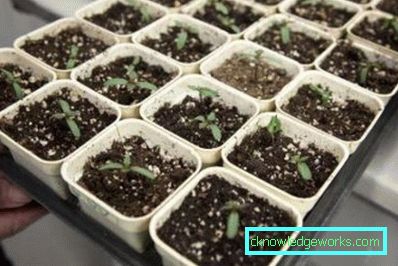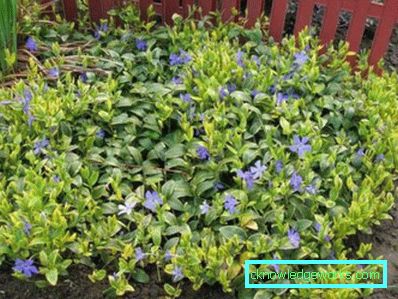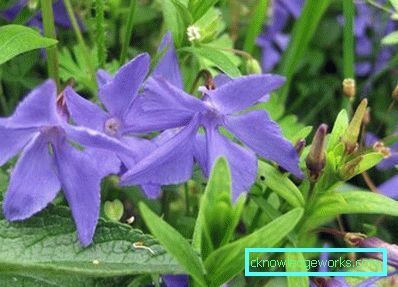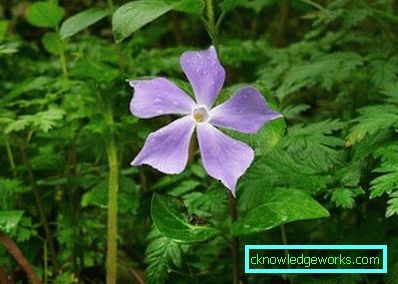Landing
There are plants that serve as magic wands for gardeners. With their help, you can quickly fill the voids in the area, or once planted a plant, for many years not to care about plantings. These plants include the periwinkle groundcover, the planting and cultivation of which is described in our article.


Periwinkle description
Periwinkle is a groundcover plant that will delight a novice grower. Literally, you can stick a piece of the shoot into the ground, where there is at least a drop of moisture, and after a while a beautiful bush with oblong wax leaves will appear in place of the cutting, gradually occupying more and more space.
Due to the botanical features of the plant. Periwinkle is a genus of creeping evergreen dwarf shrubs or perennial grasses of the family Kutrovye.


Periwinkle flowers are single, pyatilepestkovye, flower stalks are placed in the leaf axils. Most often they are blue, lilac, pale purple. Dense leaves of the plant are located on the stem opposite each other. The color of the leaves, depending on the type or variety, can be from light green to dark green tones, and in some species - with cream, golden divorce or border.
Mass flowering begins in spring. After it ends, single flowers continue to delight themselves throughout the rest of the season.
What places and soil prefers
Periwinkle can grow on any soil, in bright sun and in the shade. But, undoubtedly, this plant has preferences both to the soil and to the place of cultivation, where it feels as comfortable as possible.
In the garden area periwinkle is better to plant in pristenennye places. On nutrient, loose, neutral soils, it grows more actively and blooms longer. The most suitable for this are tree trunks circles of fruit trees, such as cherries, pears, and apple trees.


Planted in marshy soils, periwinkle will not grow, because it does not tolerate overwetting. It is possible to prepare the ground for planting periwinkle: by enriching the sandy soil with humus, and clay soil by diluting with sand.
How can you grow periwinkle
Periwinkle is propagated, like many perennial crops, in several ways:
1. Sowing seeds in the ground
This method is rarely used by gardeners, as a full-fledged plant will have to wait two years. This plant will bloom only in the second year.
Planting of periwinkle seeds can be made in early spring or in the winter right in open ground:
- Prepare the soil: dig, remove weeds, moisten;
- Make in the prepared soil grooves with a depth of 2 - 3 cm, with a distance of 10 cm between the rows;
- Sow seeds, sprinkle with earth and water.
2. Rassadny method of growing
Growing periwinkle seeds can be done through seedlings


- In early spring, seedlings are sown in a soil mixture consisting of peat, sand and vermiculite or into peat tablets.
- In the soil mixture, the seeds are sealed to a depth of 1.5 cm, maintaining a distance of 4-5 cm between them. 2-3 seeds are sown in a pre-soaked peat tablet.
- Crops are placed in a warm (+ 23 ... + 25 degrees) and dark place.
- After the seedlings appear, the temperature of the seedlings content should be reduced to + 18 ... + 20 degrees. This is necessary so that the seedlings are not stretched out.
- At the same time, containers with seedlings are moved to a well-lit place.
- Further shoots need moderate watering.
- Top dressing is necessary in 2-3 weeks after emergence of shoots.
- In the presence of 4 of these sheets of seedlings can dive into separate pots.
3. Cutting
Propagation by cuttings can be carried out from spring to autumn in the presence of material for grafting.
Suitable blanks for cuttings are the segments of the shoots with the root buds in the internodes, but the segments are suitable and without roots. Shoots without roots also take root, but a little later.
Plant cuttings can be immediately on the chosen place or on a seedling bed. Step by step the cutting process looks like this:
- Before planting the cuttings, the soil is dug up, nitrogen fertilizers are applied - 20 gr. on apt. m
- The shoots are cut into cuttings with 2-3 internodes;
- Only one pair of leaves is left on the handle; the remaining leaves are removed;
- Bury cuttings, leaving a couple of leaves on the surface;
- The distance between the cuttings (subject to landing on a permanent place) is kept at 30 cm;
- Landings are periodically watered, and at high temperatures they also carry out spraying.

Cuttings root quickly enough and begin to grow actively.
4. layering
It is because of the high ability to quickly take root from any node on the stem, the periwinkle is recognized as a symbol of vitality and vitality.
- Creeping periwinkle shoots in the field of internodes take root when in contact with the soil. You can help them in this by sprinkling the escape in the area of internodes with earth. This will be the layering.
- Then the rooted shoot is cut with a shear into several parts (the amount depends on the length of the whip).
- Undermine a segment in the place of rooting, trying not to damage the roots.
- Layers planted in the planned place.
- Even if the roots on the layers are small, the sapling does not need to be covered.
It is enough to apply layers from direct sunlight and to keep the ground under the layers constantly wet.
Periwinkle care
Periwinkle is so good that it requires a minimum of effort to care for him. It is well dispensed by people, but it responds positively to the extra care.


- To improve the bushiness of the plant, it is necessary to nip old and new shoots.
- Since this is a drought-resistant plant, it needs watering in the initial stages of development. Subsequently, it is enough moisture in the soil. Even in very hot summers it is not recommended to water the periwinkle more than once a week.
- Periwinkle grows even on poor soils, but it responds well to fertilizing with urea (35 g per sq. M), to adding leaf humus to the soil (at the beginning of the growing season and at the end of the season). The leaves of the plant itself, gradually dying off, are also organic fertilizer.
- No need for weeding: growing rapidly, shoots tightly cover the soil, depriving the weeds of the ability to grow.
- Periwinkle groundcover frost-resistant, except for thermophilic varieties and young shoots.
- It looks attractive after flowering, but there is a trick to improve the appearance and provoke repeated flowering. To do this, remove dried flowers from the plant and shorten too long shoots.
Cut the tops of the stems used for propagation of the culture. It is enough to plant them in a moist light ground.
Periwinkle in garden design
Periwinkle - an excellent ornamental plant. It is planted in wide borders, bordering rabatok, in decorating and strengthening the gentle bare slopes, in the design of the border between flower beds and paths.


Perennial quickly grows and hide ugly terrain under a beautiful, colorful carpet with blue spots of flowers. It can act as a tamper shrub planting, without interfering with their growth.
It looks beautiful as an amulet plant in the compositions of hanging baskets or hanging from stony walls.
Colorful spots in flower beds are varieties with variegated leaves. Periwinkle favorably emphasizes and emphasizes the individuality of the cultures next to it.
Diseases and pests.
Periwinkle withstand the onslaught of pests and diseases. Most likely defeat aphids and shield. For the destruction of harmful insects used spraying plants with a solution of green soap.
One of the most common diseases is rust. A symptom of infection with rust, a fungal infection, is an orange plaque on the stems and leaves.
For treatment, plants should be treated with fungicides 2 times with an interval of 2 weeks. To prevent the spread of the disease, the affected shoots should be cut and burned.


Wintering plants
Most varieties tolerate the winter cold without shelter, but if the plant is young or thermophilic, it is better to cover it with foliage or spruce branches. Compost or peat for these purposes will not work, since it is difficult to clear the plants from them in the spring.
Periwinkle varieties
Several species of periwinkle groundcover are most common in gardening:
Great periwinkle
Distributed in the southern regions. This unpretentious view, towering above the ground up to 30 cm, has evergreen matted large leaves, pubescent along the edges and 4 - 8 cm long.


The flowers are bright blue with a diameter of 3-5 cm. Under favorable conditions, blooming occurs twice a year (in May and September).
Great periwinkle prefers partial shade, is able to rapidly fill a large area. This species is more often planted with single clumps. For the winter, the plants must be covered with spruce.
Among gardeners, varieties derived from the variegated (variegated) form of the periwinkle large are popular:
- Expoflora - bright green leaves with a bright border.
- Maculata - leaves are dark green at the edges with a bright middle.
- Reticulata - flowers of a bright lilac shade with a pale middle.
Periwinkle
Distributed in the middle lane, in the western and northern regions of Russia. Frosts easily transfers, does not require shelter.


Unpretentious view with erect peduncles 15–20 cm high. The ellipse-drawn, dark green opaque leaves remain on the plant all year round. Blue flowers, 2-3 cm in diameter, delight in flowering in May -June.
Adult leaves are replaced by young ones gradually, not all at once, therefore there are no voids in the thickets.
With careful care, small periwinkle may re-bloom in August. View is not subject to trampling. This species differs in that it is capable of forming thick and dense carpets from greenery.
Some popular varieties are:
- Atropurpurea - flowers of saturated lilac color,
- Emili - white flowers
- Illumination - purple flowers. Golden leaves with green border.
- Blue Drift - flowers of gentle-violet color, leaves are light green.
Periwinkle herbaceous
It is found in southwest Russia, in the Crimea, in the Caucasus, Central Asia, and Ukraine. This type is most loved by gardeners for simplicity, vitality and minimal care.


He throws out long (up to 1 m and more) creeping stems. The leaves are oval, small, rough, dark green, 3–4 cm long. Forms a looser cover than a small periwinkle. Flowering purple single flowers begins in mid-June and lasts 20-25 days.
Prefers landing on high, dry, sunny places. It has low frost resistance, leaves drop in winter, and in the spring leaves grow back. Shoots do not take root in internodes. During fruiting, only the tip takes root. The flowers are purple, blue or blue-violet.
Periwinkle pubescent
Distributed in the forests of the western Caucasus. It has creeping stems, reaching a length of more than 100 cm, well rooted in contact with the soil.


Flowering lasts from May to June. Peduncles rise above the green mass of leaves and stems, creating the effect of loose carpet. Flowers are blue, up to 3 cm in diameter. In autumn, pubescent periwinkle drops leaves.
In frosty winters it requires shelter with dry foliage, since young shoots freeze when the temperature drops below -10 degrees.
Having only positive qualities in its arsenal, periwinkle wins the hearts of gardeners for many years. Therefore, it is increasingly possible to see this unpretentious plant not only at the forest edge, but also at home and garden plots.
